Republic of Seychelles
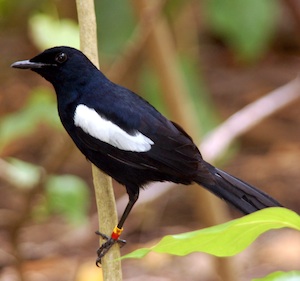
Seychelles is an island country and archipelagic state consisting of 155 islands (as per the Constitution – a further 7 reclaimed islands have been created subsequent to the publication of the Constitution) in the Indian Ocean. Its capital and largest city, Victoria, is 1,500 kilometres (800 nautical miles) east of mainland Africa. Nearby island countries and territories include the Comoros, Madagascar, Mauritius, and the French overseas departments of Mayotte and Réunion to the south; and the Chagos Archipelago to the east. Seychelles is the smallest country in Africa as well as the least populated sovereign African country, with an estimated population of c.132,000 people. Nearly a third of the population live in and around the capital. It is the most developed and has the highest per capita income in Africa. Seychellois culture and society is an eclectic mix of French, British, and African influences, with infusions of Chinese and Indian elements.
The majority of the islands are uninhabited, with many dedicated as nature reserves. Seychelles’ largest island, Mahé, is located 1,550 kms from Mogadishu (Somalia’s capital). A group of 44 islands (42 granitic and 2 coralline) occupy the shallow waters of the Seychelles Bank and are collectively referred to as the inner islands. They have a total area of just 244 km2 (94 square miles), accounting for 54% of the total land area of the Seychelles and 98% of the entire population.
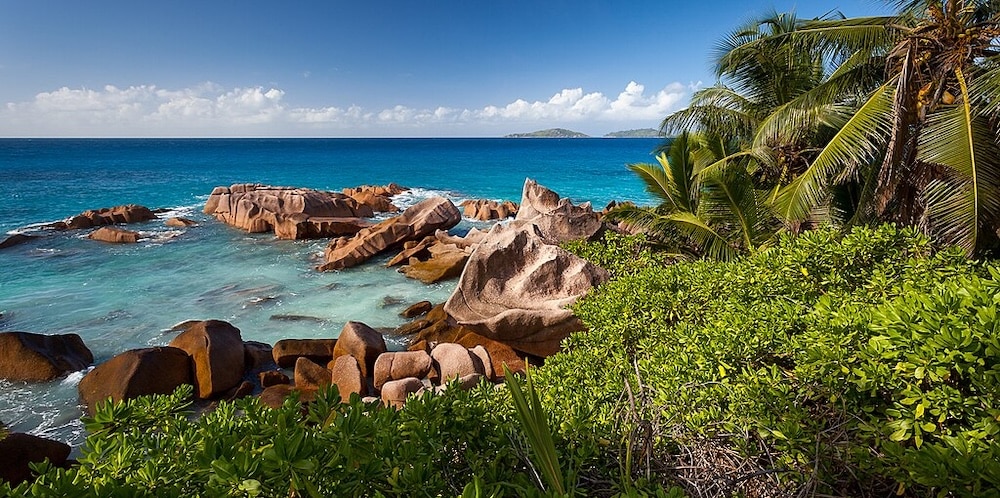
La Digue – ©Svein-Magne Tunli – tunliweb.no, CC BY-SA 4.0 via Wikimedia Commons
There are two coral sand cays north of the granitics on the edge of the Seychelles Bank: Denis and Bird. There are two coral islands south of the Granitic: Coëtivy and Platte. There are 29 coral islands in the Amirantes group, west of the granitic. here are 13 coral islands in the Farquhar Group, south-southwest of the Amirantes. There are 67 raised coral islands in the Aldabra Group, west of the Farquhar Group. The 7 reclaimed islands are Ile Perseverance, Ile Aurore, Romainville, Eden Island, Eve, Ile du Port and Ile Soleil.
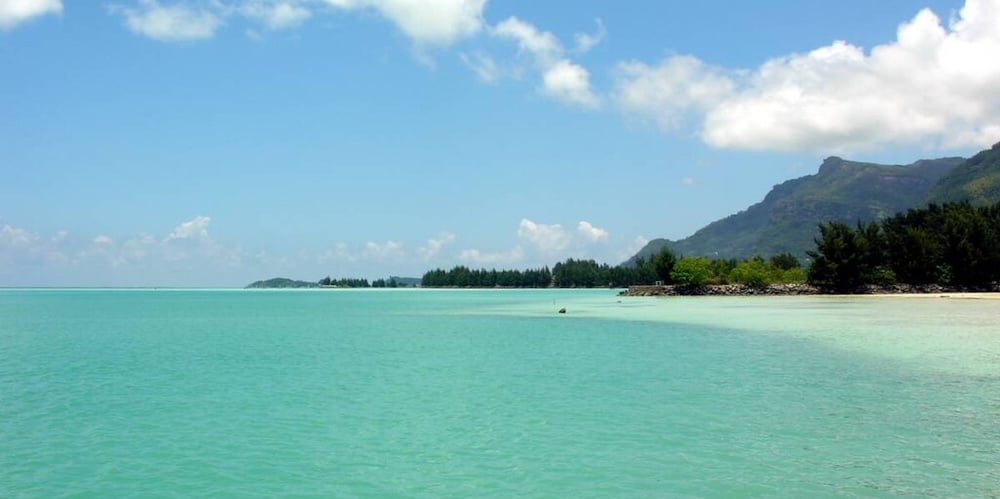
Mahé – ©Hansueli Krapf (User:Simisa) CC BY-SA 2.5 via Wikimedia Commons
South Island, African Banks has been eroded by the sea. At St Joseph Atoll, Banc de Sable and Pelican Island have also eroded, while Grand Carcassaye and Petit Carcassaye have merged to form one island. There are also several unnamed islands at Aldabra, St Joseph Atoll and Cosmoledo. Pti Astove, though named, failed to make it into the Constitution for unknown reasons. Bancs Providence is not a single island, but a dynamic group of islands, comprising four large and about six very small islets.
The climate is very humid, as the islands are small, and is classified as a tropical rain forest. The temperature varies little throughout the year. Temperatures on Mahé vary from 24 to 30 °C, and rainfall ranges from 114 inches annually at Victoria to 142 inches on the mountain slopes. Precipitation levels are somewhat less on the other islands. During the coolest months, July and August, the average low is about 24 °C. The southeast trade winds blow regularly from May to November, and this is the most pleasant time of the year. The hot months are from December to April, with higher humidity (80%). March and April are the hottest months, but the temperature seldom exceeds 31 °C. Most of the islands lie outside the cyclone belt, so high winds are rare.
Birding the Seychelles
A small landmass and geographic isolation limits the number of species compared to continental areas but size isn’t everything. For a start, the main islands (in terms of population and accessibility) are both the world’s only granitic ocean islands and the world’s oldest ocean islands. Antiquity means a high level of endemism while oceanic isolation means huge seabird colonies. Added to this, there is a remarkably high number of migrant species making up almost three-quarters of the species on the Seychelles list. Seychelles hosts some of the largest seabird colonies in the world, notably on the outer islands of Aldabra and Cosmoledo. In granitic Seychelles the largest colonies are on Aride Island including the world’s largest numbers of two species.
Seychelles is among the world’s leading countries to protect lands for threatened species, allocating 42% of its territory for conservation. Like many fragile island ecosystems, Seychelles saw the loss of biodiversity when humans first settled in the area, including the disappearance of most of the giant tortoises from the granitic islands, the felling of coastal and mid-level forests, and the extinction of species such as the chestnut flanked white eye, the Seychelles parakeet, and the saltwater crocodile. However, extinctions were far fewer than on islands such as Mauritius or Hawaii, partly due to a shorter period of human occupation. Seychelles today is known for success stories in protecting its flora and fauna. The rare Seychelles black parrot, the national bird of the country, is now protected.
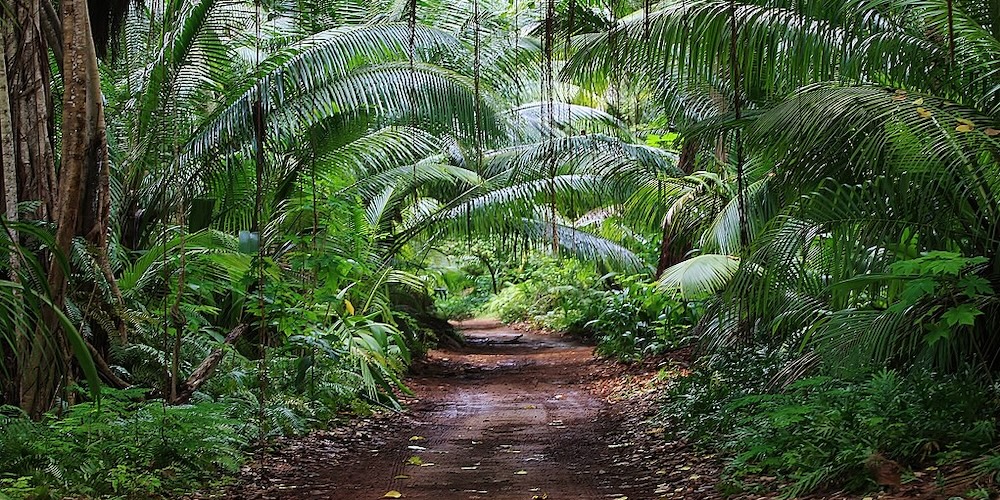
Denis Island Jungle – ©Adrian Scottow, London CC BY-SA 2.0 via Wikimedia Commons
Most birders will only visit the inner islands of the Seychelles Bank (the granite islands including Mahe, Praslin and La Digue plus the coral cays of and Bird Island and Denis). The outer islands require more time and money with accommodation available only on Desroches and Alphonse in the Amirantes and access elsewhere only possible by joining a cruise. There are 12 endemics in the granitic islands, seven of which can be seen on Mahé (including Seychelles White-eye and the only opportunity to see Seychelles Scops Owl). The other five can be seen by staying on Praslin (home to Seychelles Black Parrot) and arranging trips to La Digue for Seychelles Paradise Flycatcher and either Cousin or Aride (or both) to see Seychelles Magpie Robin, Seychelles Warbler and Seychelles Fody. Trips to Cousin are very easy to arrange. They are well organised if somewhat regimented due to numbers and of fairly short duration (about 2 hours). Nevertheless, all five endemics on the island are pretty well guaranteed (including Seychelles Magpie Robin, Seychelles Warbler and Seychelles Fody). Aride has the same five endemics but requires a full day trip and is often closed due to high seas in May-September. At other times it offers more time and space and more birds than Cousin; attractions include the world’s largest colonies of Lesser Noddy and Tropical Shearwater, the only breeding Red-tailed Tropicbirds east of Aldabra plus thousands of frigatebirds (mainly Greater but some Lesser). An alternative possibility is an excursion to Cousine, which has the same endemics as Aride and Cousin plus Seychelles White-eye. This is sometimes possible by special arrangement, but this will only be granted when the private villas on the island are unoccupied. When available it is a superb opportunity to see birds away from the crowds of non-birders and still enjoy a cold beer at the island’s bar.
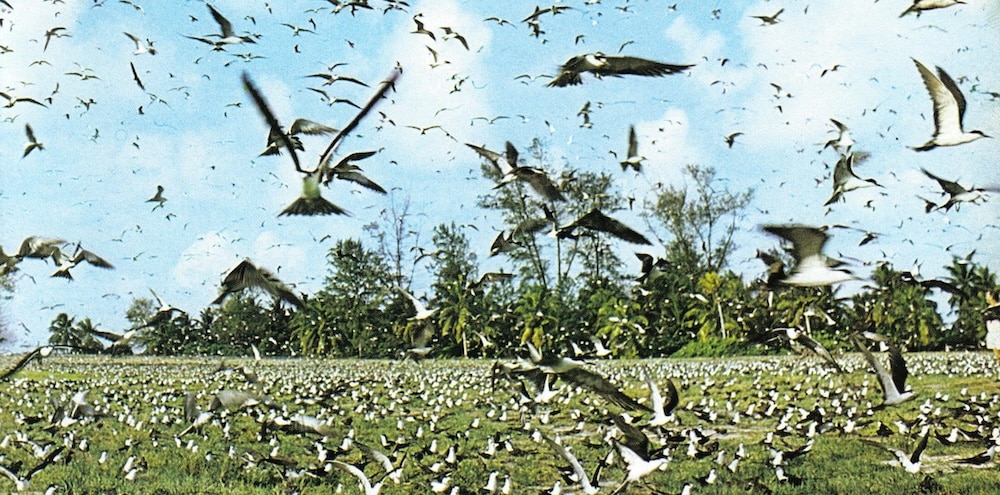
Sooty Terns nesting on Bird Island – ©Photography by Dino Sassi – Marcel Fayon, Photo Eden LTD, Public domain, via Wikimedia Commons
A visit to Bird Island (two nights stay) is a must for the serious birder. It is named after the enormous Sooty Tern colony present April-September but October-December is the most exciting time to see rarities, when almost any Eurasian migrant could turn up, due to the location of the island on the northern perimeter of the Seychelles Bank. A trip to the outer islands requires joining a cruiseship or one of a few live-aboard schooners based at Mahé. However, opportunities have become more limited since the rise of Somali piracy and currently require special permission and security arrangements. Most of the outer islands are very young, only a few thousand years, so have few land birds and no endemics except in the Aldabra group, which is more ancient. Nine of the twenty IBAS of Seychelles are in the outer islands mainly due to huge seabird colonies. The World Heritage Site of Aldabra accounts for around one-third of the landmass of Seychelles, but is uninhabited except for the warden and staff of the research station. Avian attractions include 11 seabird species and nine endemic species or subspecies, including the last flightless bird of the Indian Ocean (Aldabra Rail) and, of course, the main attraction are the healthy, yet fragile population, of 150,000 giant tortoises that live solely on the atoll.
When to go – Land birds are of course present year-round, but some are at their best during the breeding season, mainly October to March. Some seabird species are present year-round, but others breed either during the southeast monsoon (May-September) or the northwest monsoon (October-April), mainly the former. October-December is the best time to see migrants, some lingering on to April (especially waders including Crab Plover). If this is a birding trip of a lifetime the best time is mid-October to end-November combining the end of the southeast seabird season with the beginning of the northwest and the height of the migration season together with calm seas and settled weather.
-
Adrian Skerrett
| pangaea@sky.com
https://www.seychellesbirdrecordscommittee.com
-
Number of bird species: 288
(As at February 2025)National Bird: Seychelles Black Parrot Coracopsis nigra
Number of endemics: 14
Seychelles Blue-pigeon Alectroenas pulcherrimus
Seychelles Swiftlet Aerodramus elaphrus
Seychelles Scops-owl Otus insularis
Seychelles Kestrel Falco araeus
Seychelles Parrot Coracopsis barklyi
Aldabra Drongo Dicrurus aldabranus
Seychelles Paradise-flycatcher Terpsiphone corvina
Seychelles Warbler Acrocephalus sechellensis
Seychelles Bulbul Hypsipetes crassirostris
Seychelles White-eye Zosterops modestus
Seychelles Magpie-robin Copsychus sechellarum
Seychelles Sunbird Cinnyris dussumieri
Aldabra Fody Foudia aldabrana
Seychelles Fody Foudia sechellarum
-
Avibase
PDF ChecklistThis checklist includes all bird species found in Seychelles , based on the best information available at this time. It is based on a wide variety of sources that I collated over many years. I am pleased to offer these checklists as a service to birdwatchers. If you find any error, please do not hesitate to report them. -
E-Bird
PDF ChecklistThis checklist is generated with data from eBird (ebird.org), a global database of bird sightings from birders like you. If you enjoy this checklist, please consider contributing your sightings to eBird. It is 100% free to take part, and your observations will help support birders, researchers, and conservationists worldwide. -
Wikipedia
Annotated ListThis is a list of the bird species recorded in the Seychelles. It includes a total of 279 species have been accepted by Seychelles Bird Records Committee (SBRC) as recorded in Seychelles up to 25 October 2022...
-
A Checklist of the Birds of Seychelles
| By Adrian Skerrett | Lulu Press | 2007 | Paperback | 100 pages, Graphs | ISBN: 9781847530745 Buy this book from NHBS.com -
Birds of the Indian Ocean Islands
| (Madagascar, Mauritius, Réunion, Rodrigues, Seychelles and the Comoros) | Ian Sinclair & Olivier Langrand | New Holland Publishers | 2013 | Paperback | 264 pages, 71 plates with 1160 colour illustrations; colour distribution maps | Out of Print | ISBN: 9781431700851 Buy this book from NHBS.com -
Birds of the Seychelles
| By Adrian Skerrett & Tony Disley | Christopher Helm | 2011 | Paperback | 176 Pages, 65 Colour Plates, Black & White Illustations, Maps | ISBN: 9781408151518 Buy this book from NHBS.com -
Complete Birds of Seychelles
| By B Narainsamy Ramen & Adrian Skerrett | Narainsamy Ramen | 2016 | Hardback | 304 Pages, Colour Photos | ISBN: 9789994902958 Buy this book from NHBS.com -
Wildlife of Seychelles
| By John Bowler | WILDGuides | 2006 | Hardback | 192 pages, 51 col plates | ISBN: 9781903657140 Buy this book from NHBS.com
-
African Bird Club
WebpageSeychelles is world-renowned for its idyllic tropical beaches and, among birders, for its endemics and its seabird colonies. Seychelles comprises over 115 islands scattered across 1,374,000 km2 of the western Indian Ocean. Once sandwiched between Africa and India as part of Gondwanaland, Seychelles split off from Africa some 127 million years ago and from India about 65 million years ago. The 40 central islands are granitic not only are they the only granitic oceanic islands in the world; at 750 million years old, they are also the oldest islands in the world… -
Island Conservation Society
Website'The Society promotes the conservation and restoration of island ecosystems, sustainable development of islands, and awareness of their vulnerability and vital importance to the planet's biodiversity.' -
Marine Conservation Society Seychelles
WebsiteThe Marine Conservation Society Seychelles (MCSS) is a Non-Governmental Organisation registered in Seychelles which promotes the conservation of the marine environment through education, research and the implementation of a number of programmes. Current activities include long running monitoring programmes on turtles and terrapins, as well as several grant funded programmes and projects. -
Nature Protection Trust
WebsiteFrom 1992 to 2012 Nature Protection Trust of Seychelles worked to preserve the species andenvironments of the Seychelles islands through practical conservation, researchand publication. -
Nature Seychelles
WebsiteWe are a change-making NGO in the Seychelles rolling out world-acclaimed environmental projects such as the rescue of critically endangered birds and sea turtles, and coral reef restoration. -
Nature Seychelles - Bird Conservation
WebsiteNature Seychelles Science Programme focuses on research, monitoring, and management of threatened endemic wildlife and their habitats. -
Seychelles Bird Records Committee
WebsiteNews of all birds recorded in Seychelles -
Seychelles Islands Foundation
WebsiteSeychelles Islands Foundation (SIF) manages and protects the World Heritage Sites of Aldabra and Vall -
Seychelles National Parks Authority
WebsiteThe Seychelles National Parks Authority (SNPA) is responsible for all of the marine and terrestrial national parks of Seychelles and a number of these parks have been designated since 1979. The terrestrial parks include Morne Seychellois National Park, the Praslin National Park and the Veuve Reserve on La Digue. The Marine National parks includes Ste. Anne (one of the first marine protected area in the Indian Ocean), Silhouette, Port Launay, Baie Ternay, Ile Coco, Curieuse & Saint Pierre.
-
IBAs Seychelles Important Bird Areas
WebpageSatellite ViewSeychelles is of great ornithological interest. It has 30 currently recognised endemic forms of landbirds and waterbirds, including 12 terrestrial species, which show biogeographic influences from Africa, Asia and Madagascar. Eleven species of global conservation concern occur which include 9 of the endemic landbirds while one other is an endemic warbler from Aldabra, Aldabra Warbler Nesillas aldabrana, which has not been seen since 1983 and is now considered extinct… -
NP Morne Seychellois
WebpageSatellite ViewThe Morne Seychellois National Park is situated on the island of Mahe, the largest island of the Seychelles archipelago. Morne Seychellois covers an area of approximately 3,045 hectares, more than 20% of Mahe and made up of a mixture of mangroves, lush tropical jungles and tall mountains. It is 10km in length and between 2km and 4km wide, equipped with an extensive trail network, covering more than 15km. -
NP Praslin
WebpageSatellite ViewThe Praslin National Park was established in 1979 and is the second largest terrestrial National Park in the Seychelles. As the name suggests it is located on the second largest island, Praslin. It covers a total surface area of 324 ha of the upper lands of Praslin and includes the World Heritage site of the Vallée de Mai. Its altitude ranges from 80 meters in the ravines to 367m at the highest point of the island. It offers a wide variety of landscapes and viewpoints. -
NP Veuve Special Reserve
WebpageSatellite ViewIn the 1960's, the rarity of the Seychelles Black Paradise Flycatcher was a cause for concern, so that in 1970, a local man, Abraham Niole, was employed to protect and monitor the birds and their nests, by the Royal Society for Nature Conservation (RSNC). In 1980-1981, Christopher Cadbury and Tony Beamish initiated a reserve for the Veuve. The area of land, which currently makes up the reserve, was leased by the RSNC from Mrs Rene Payet. The fenced reserve was managed by the RSNC and the Seychelles National Parks and Nature Conservancy Commission.… -
NR Aride Island
WebsiteSatellite ViewAride is the northernmost island of the granitic Seychelles, it is roughly 68 hectares in area (approximately 0.67 km 2), and 1.6 km long and 0.6 km wide and alongside Aldabra, Aride has one of the most important seabird populations in the Indian Ocean. Eighteen species of native birds (including five only found in Seychelles) breed on Aride, this is far more than on any other granitic island. The island is leased and managed as a nature reserve by the Island Conservation Society of Seychelles but is presently owned by the UK Registered Charity Island Conservation Society UK The only human inhabitants are the reserve's staff, currently four Seychellois rangers and two Island Wardens. They live in small plantation houses close to the beautiful coral sand beach overhung by palms on the south side of the island… -
SR Cousin Island
WebpageSatellite ViewCousin Island is a granitic island covering 27 hectares and lies approximately 2km from Praslin island. It became the world’s first internationally owned-reserve when it was purchased in 1968 by the International Council for the Protection of Birds (ICBP), now Birdlife International. The objective was to save the last remaining population of the Seychelles warblers… -
Vallée de Mai Nature Reserve
InformationSatellite ViewThe most noteworthy bird is the endemic subspecies of black parrot Coracopsis nigra barklyi (E); restricted to Praslin Island and totally dependent on the Vallée de Mai and the surrounding palm forest. A census in 1994 recorded 108 birds. Other birds include: the endemic Seychelles Bulbul Hypsipetes crassirostris, Blue Pigeon Alectroenas pulcherrima, Seychelles Sunbird Nectarinia dussamieri, Seychelles Kestrel Falco araea and an endemic Cave-nesting Swiftlet Collocalia francica elaphra. Exotic birds include Indian Mynah Acridotheres tristis and Barn Owl Tyto alba affinis…
-
eBird
SightingseBirding This Month
-
BirdFinders
Tour OperatorWe will be staying in lovely beachside accommodation on both Mahe and Praslin, also visiting Cousin and La Digue islands. -
BirdQuest
Tour OperatorSEYCHELLES, MAURITIUS, RODRIGUES & RÉUNION – Indian Ocean Islands endemics and seabirds in an Earthly Paradise -
Birding Africa
Tour OperatorComoros, Mauritius, Reunion, Seychelles -
HeatherLea
Tour OperatorBirding for endemics in an island paradise -
Nature Travel Birding
Tour OperatorWe’re going on an Aldabra birding expedition in the Seychelles; home to 62 breeding bird species, of which 14 are endemic. -
NatureTrek
Tour OperatorA 14-day holiday in search of the unique birdlife and natural history of the mountains, forests and islands of the Seychelles. -
New Horizons
Tour OperatorArriving on Mahe, the birding begins with a lovely little Seychelles Kestrel sitting on the girders inside the open plan airport building, while the airport café clientele includes sparrow-sized Barred Ground Doves around our feet! -
Ornis Birding Expeditions
Tour Operatorhort tour to some of the most endemic-rich small islands in the Indian Ocean! -
Reef & Rainforest
Tour OperatorAvian Adventures in the Seychelles -
Rockjumper
Tour OperatorIndian Ocean Islands - Mauritius, Rodrigues, Réunion & Seychelles(12 days) -
Seychelles Travel
Local Tour OperatorSeychelles offers the birding enthusiasts the opportunity of viewing a number of critically endangered species, 11 endemic species and 4 endemic sub-species such as the Seychelles Kestral (Falco araea), Seychelles Blue Pigeon (Alectroenas pulcherrima), Seychelles Scops Owl (Otus insularis), Seychelles Swiftlet (Aerodramus elaphrus), Paradise Flycatcher (Terpsiphone corvina), Seychelles Bulbul (Hypsipetes crassirostris), Magpie Robin (Copsychus sechellarum), Seychelles Brush Warbler (Acrocephalus modesta), Seychelles Fody (Foudia sechellarum, Seychelles Sunbird (Nectarinia dussumieri), Seychelles White Eye (Zosterops modesta).
-
2018 [02 February] - Ross Gallardy
ReportI was exhausted (and still partly jet-lagged) and was intermittently sleeping in the back seat of the car when Ross came back to get me. I am taken only a couple meters down from the car and had perched eye level views of a Seychelles Scops-Owl! It was nearly 2am, but the bird that so many birders complain about being impossible was found. -
2018 [04 April] - Pat & Judy Hayes - Seychelles & Dubai
ReportIf you are looking for a full-on trip report of the Seychelles you would be advised to look elsewhere. This is a holiday/celebration with our passion for birds being indulged a little. Jude has always wanted to visit some of the coral islands found in the Indian Ocean, so this was the excuse we were looking for, more a holiday than a full-on bird trip. -
2018 [07 July] - Bill and Helen Simpson
PDF ReportA very easy trip with short distances to travel and easy birds, made more interesting by having to visit the other islands for their endemics. The toughest bird was the White-eye only being seen on one day out of four short visits. -
2018 [11 November] - Machiel Valkenburg
Report.... In the afternoon we made an outing to find the rare Seychelles White-eye, Seychelles Blue-Pigeon, and Seychelles Sunbird. Rapidly they were found, and good looks were enjoyed by all... -
2020 [02 February] - David Karr
PDF ReportA week-long family holiday to the central Seychelles islands, visiting the granitic islands of Mahé, Praslin, La Digue and Aride, (all are necessary to cover the thirteen endemic species). We managed to connect with all targets with relative ease, with the notable exception of Seychelles Scops Owl – which was a dip despite three valiant attempts in less-than-ideal, misty and rainy conditions. -
2022 [10 October] - Anjana
ReportSeychelles, Mauritius & Réunion -
2024 [02 February] - John Lee
PDF ReportThis was a trip together with my wife so it was not totally dedicated to birding. However, I did manage to see all 12 endemics available on Mahe, Praslin, Cousin and La Digue as well as picking up some good seabirds, Crab Plover and the widespread White (Fairy) Tern.
-
SeyVillas
Your holidays should be a unique experience.?We advise you and together we will create an individual dreamlike holiday package. The Seychelles are one of the most attractive destinations worldwide, set in the beautiful Indian Ocean. We are looking forward to introducing you a very special offer. We have visited all of our accommodations personally to ensure high quality and to come up to your expectations

